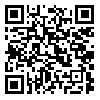Volume 12, Issue 1 (Winter 2024)
Iran J Health Sci 2024, 12(1): 39-48 |
Back to browse issues page
Ethics code: IR.MUMS.REC.1400.248
Clinical trials code: Not Applicable
Download citation:
BibTeX | RIS | EndNote | Medlars | ProCite | Reference Manager | RefWorks
Send citation to:



BibTeX | RIS | EndNote | Medlars | ProCite | Reference Manager | RefWorks
Send citation to:
Talkhi N, Akbari Sharak N, Yousefi R, Salari M, Sadati S M, Shakeri M T. Predicting COVID-19 Mortality and Identifying Clinical Symptom Patterns in Hospitalized Patients: A Machine-learning Study. Iran J Health Sci 2024; 12 (1) :39-48
URL: http://jhs.mazums.ac.ir/article-1-875-en.html
URL: http://jhs.mazums.ac.ir/article-1-875-en.html
Nasrin Talkhi 

 , Nooshin Akbari Sharak
, Nooshin Akbari Sharak 

 , Razieh Yousefi
, Razieh Yousefi 

 , Maryam Salari
, Maryam Salari 

 , Seyed Masoud Sadati
, Seyed Masoud Sadati 

 , Mohammad Taghi Shakeri *
, Mohammad Taghi Shakeri * 




 , Nooshin Akbari Sharak
, Nooshin Akbari Sharak 

 , Razieh Yousefi
, Razieh Yousefi 

 , Maryam Salari
, Maryam Salari 

 , Seyed Masoud Sadati
, Seyed Masoud Sadati 

 , Mohammad Taghi Shakeri *
, Mohammad Taghi Shakeri * 


Social Determinants of Health Research Center, Mashhad University of Medical Sciences, Mashhad, Iran. , ShakeriMT@mums.ac.ir
Abstract: (2517 Views)
Background and Purpose: Identifying effective symptoms, demographic information, and underlying diseases to predict COVID-19 mortality is essential. We aimed to study the effective clinical and symptomatic characteristics of COVID-19 mortality in hospitalized patients with positive polymerase chain reaction (PCR) test results.
Materials and Methods: For this study, we prospectively collected complete data on 26867 hospitalized individuals who tested PCR positive for COVID-19 from February 20, 2020, to September 12, 2021, in the Khorasan Razavi Province, Iran. We analyzed the data using artificial neural networks (ANN) and logistic regression (LR) models.
Results: The accuracy of the ANN model was higher than the LR (90.27% versus 90.15%). The ten most important predictors that contributed to the prediction of death were decreasing consciousness level, cough, PO2 level, age, chronic kidney disease, fever, headache, smoking status, chronic blood diseases, and diarrhea using the ANN model.
Conclusion: In conclusion, individuals suffering from chronic diseases such as cancer, kidney and blood diseases, as well as immunodeficiency are at a higher risk of mortality. This important finding can help decision-makers and medical professionals in their efforts to consider these conditions and provide effective preventative measures to reduce the risk of death.
Materials and Methods: For this study, we prospectively collected complete data on 26867 hospitalized individuals who tested PCR positive for COVID-19 from February 20, 2020, to September 12, 2021, in the Khorasan Razavi Province, Iran. We analyzed the data using artificial neural networks (ANN) and logistic regression (LR) models.
Results: The accuracy of the ANN model was higher than the LR (90.27% versus 90.15%). The ten most important predictors that contributed to the prediction of death were decreasing consciousness level, cough, PO2 level, age, chronic kidney disease, fever, headache, smoking status, chronic blood diseases, and diarrhea using the ANN model.
Conclusion: In conclusion, individuals suffering from chronic diseases such as cancer, kidney and blood diseases, as well as immunodeficiency are at a higher risk of mortality. This important finding can help decision-makers and medical professionals in their efforts to consider these conditions and provide effective preventative measures to reduce the risk of death.
Keywords: Machine learning, SARS-CoV-2, COVID-19 diagnostic testing, Logistic regression, Neural network
Type of Study: Original Article |
Subject:
Infectious Diseases and Tropical Medicine
Send email to the article author
| Rights and permissions | |
 |
This work is licensed under a Creative Commons Attribution-NonCommercial 4.0 International License. |






